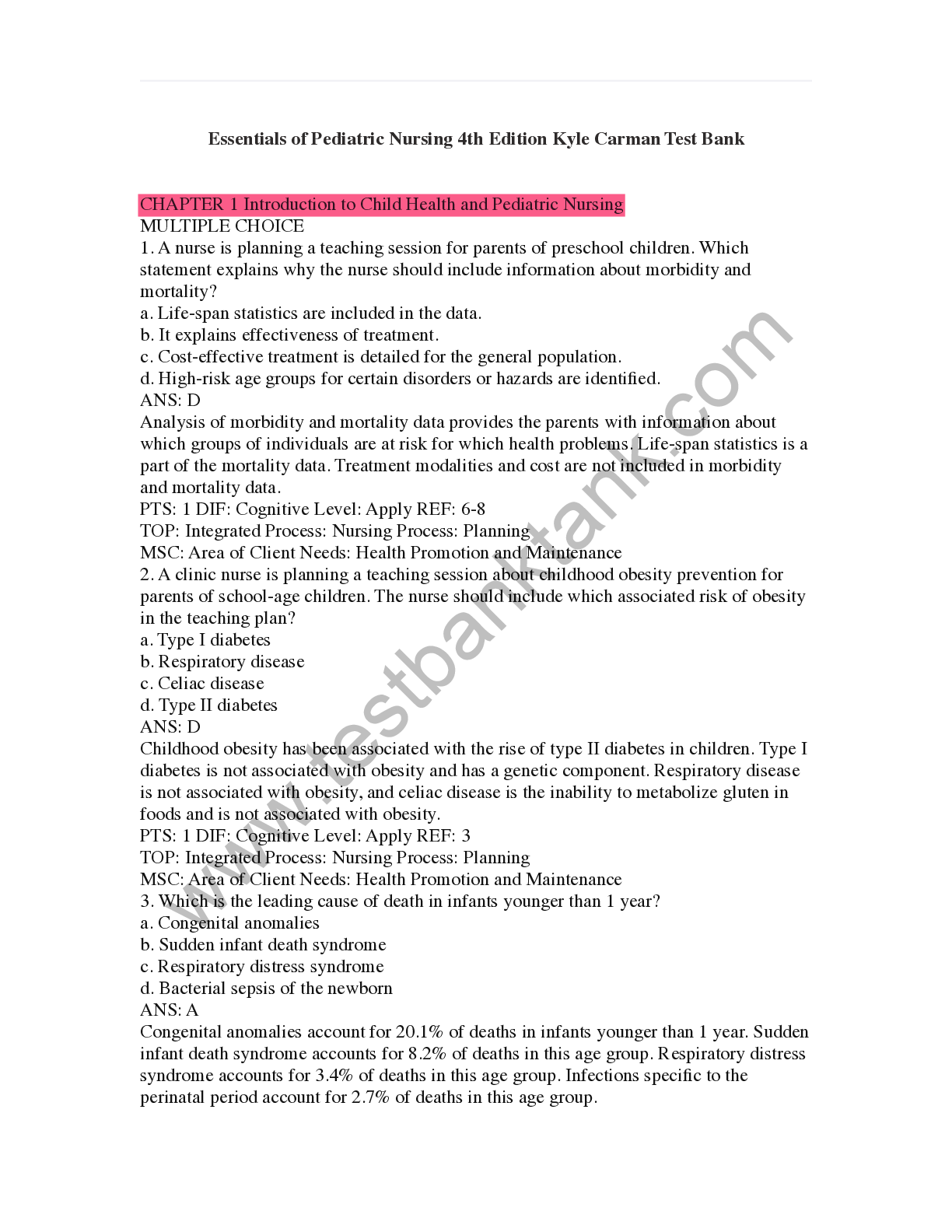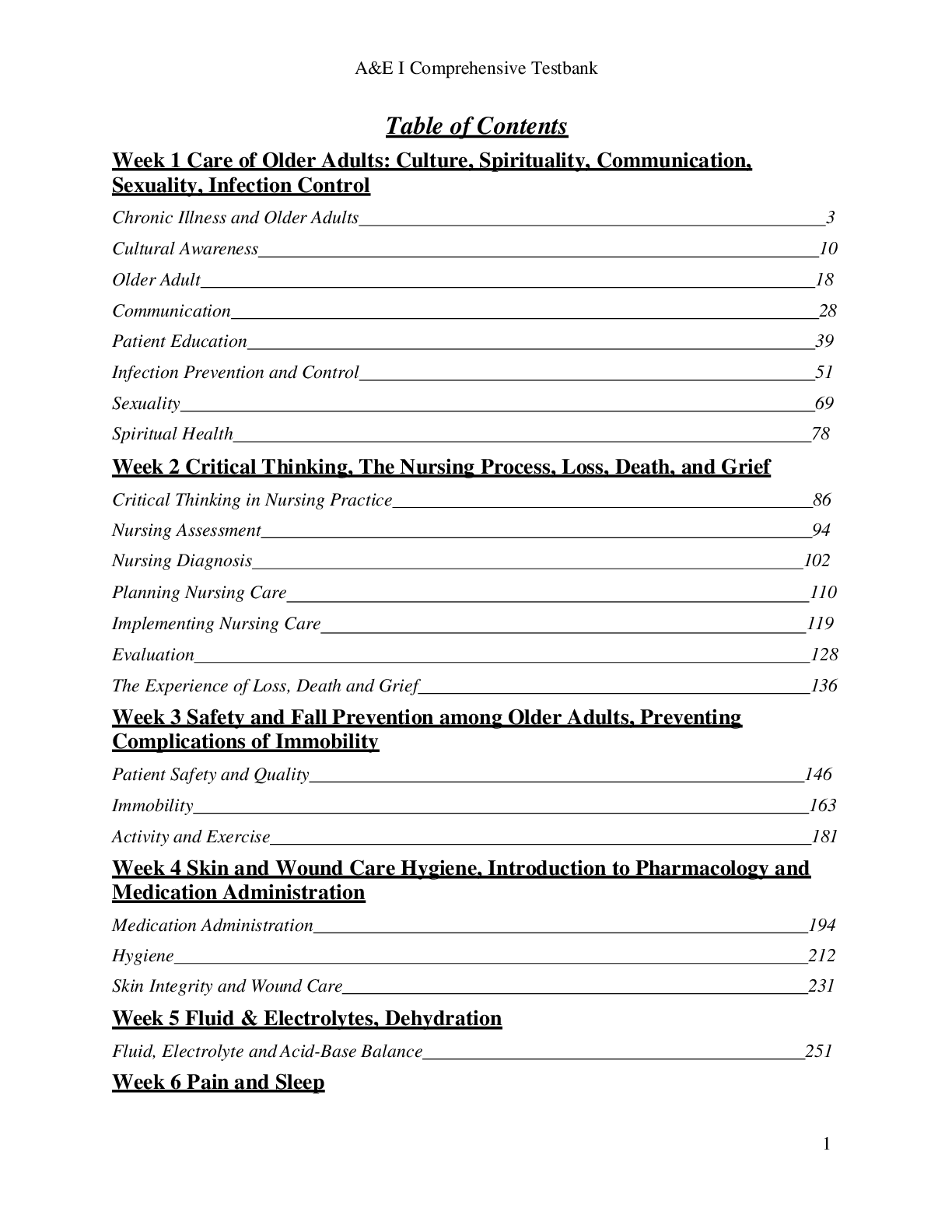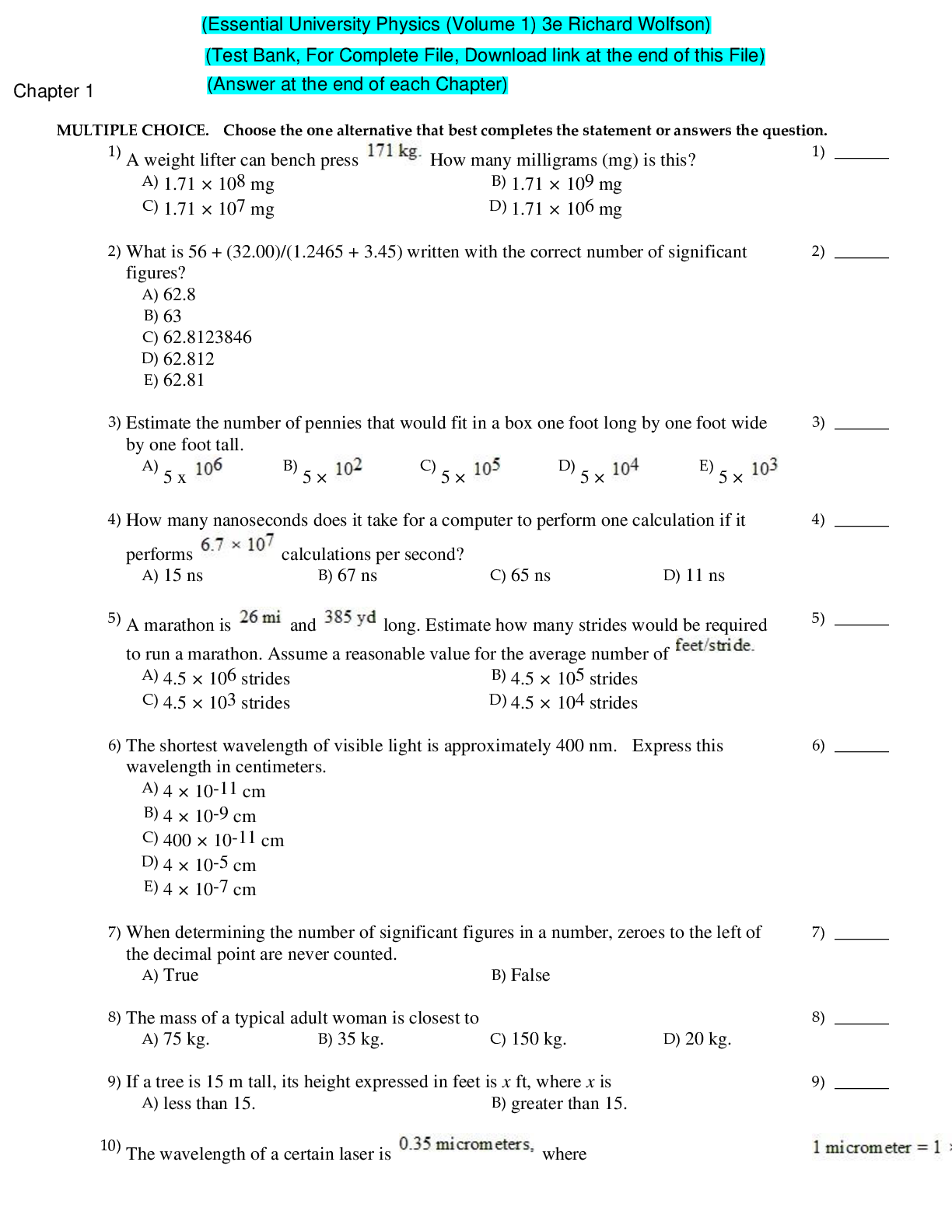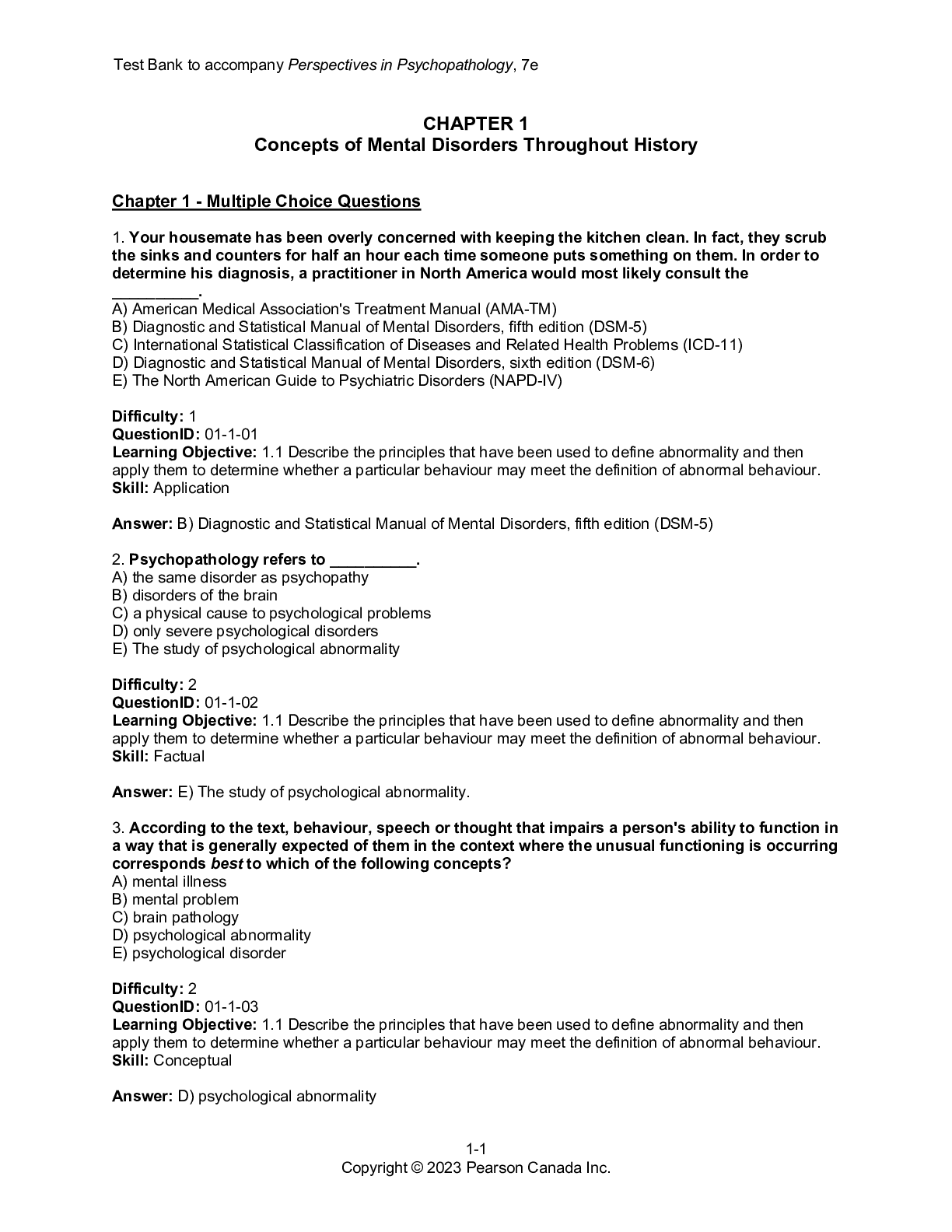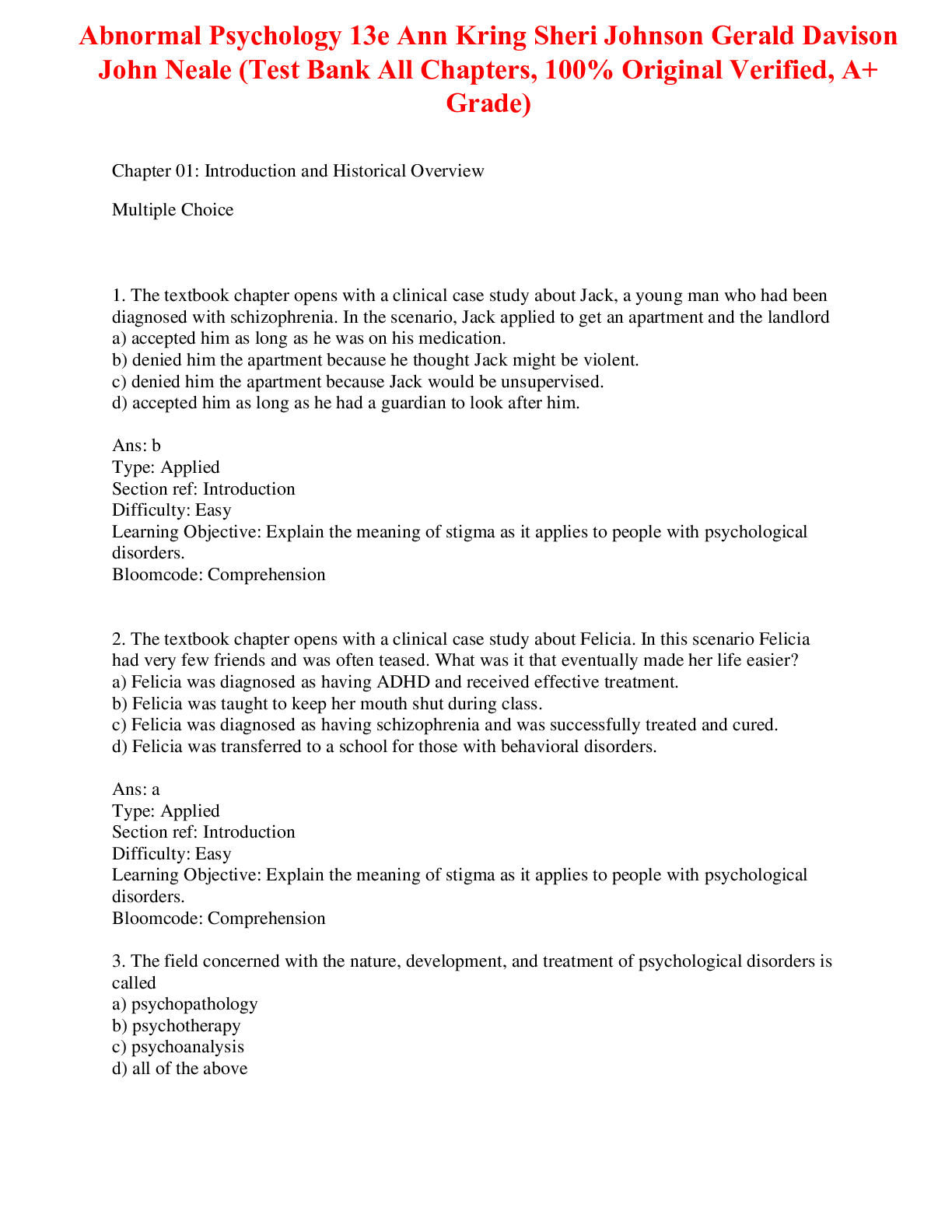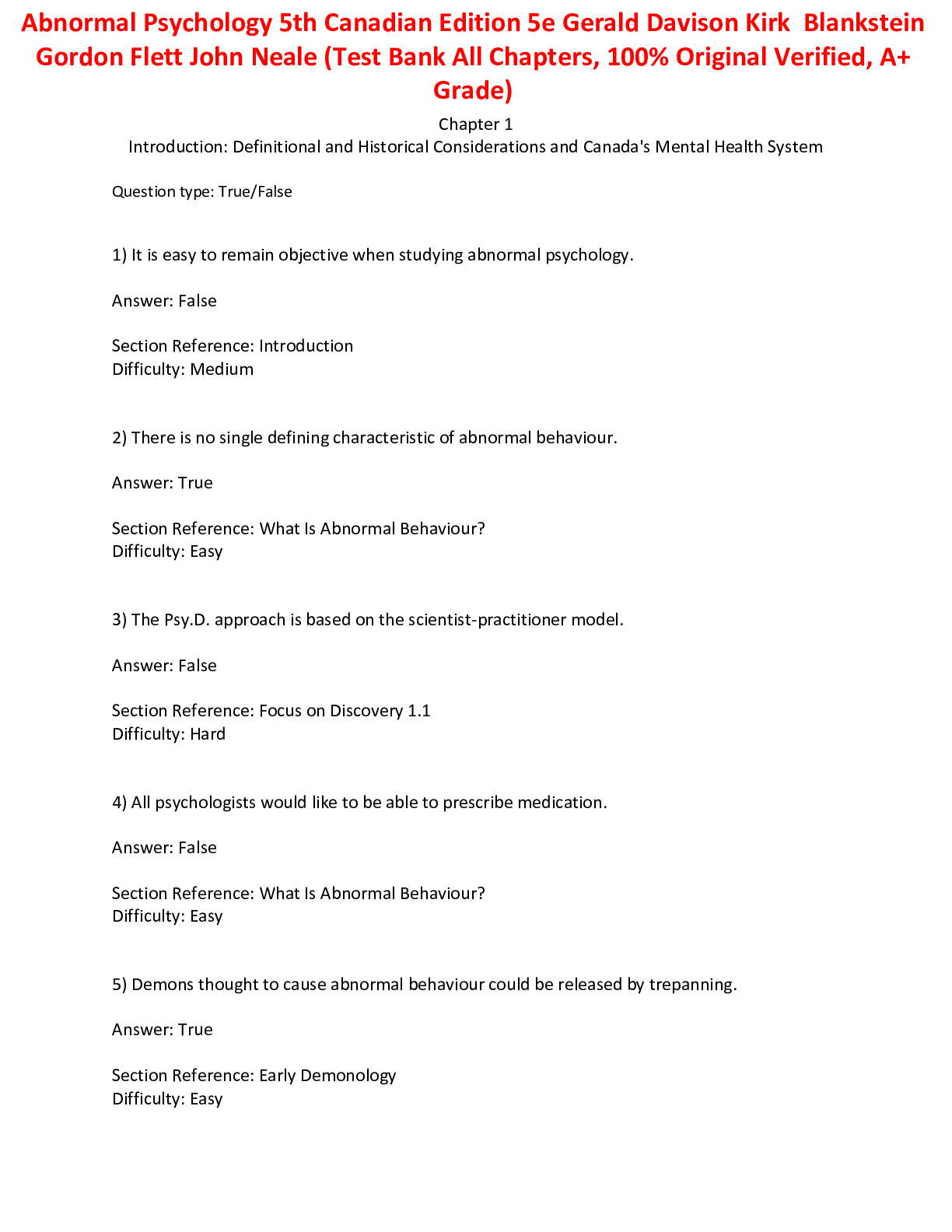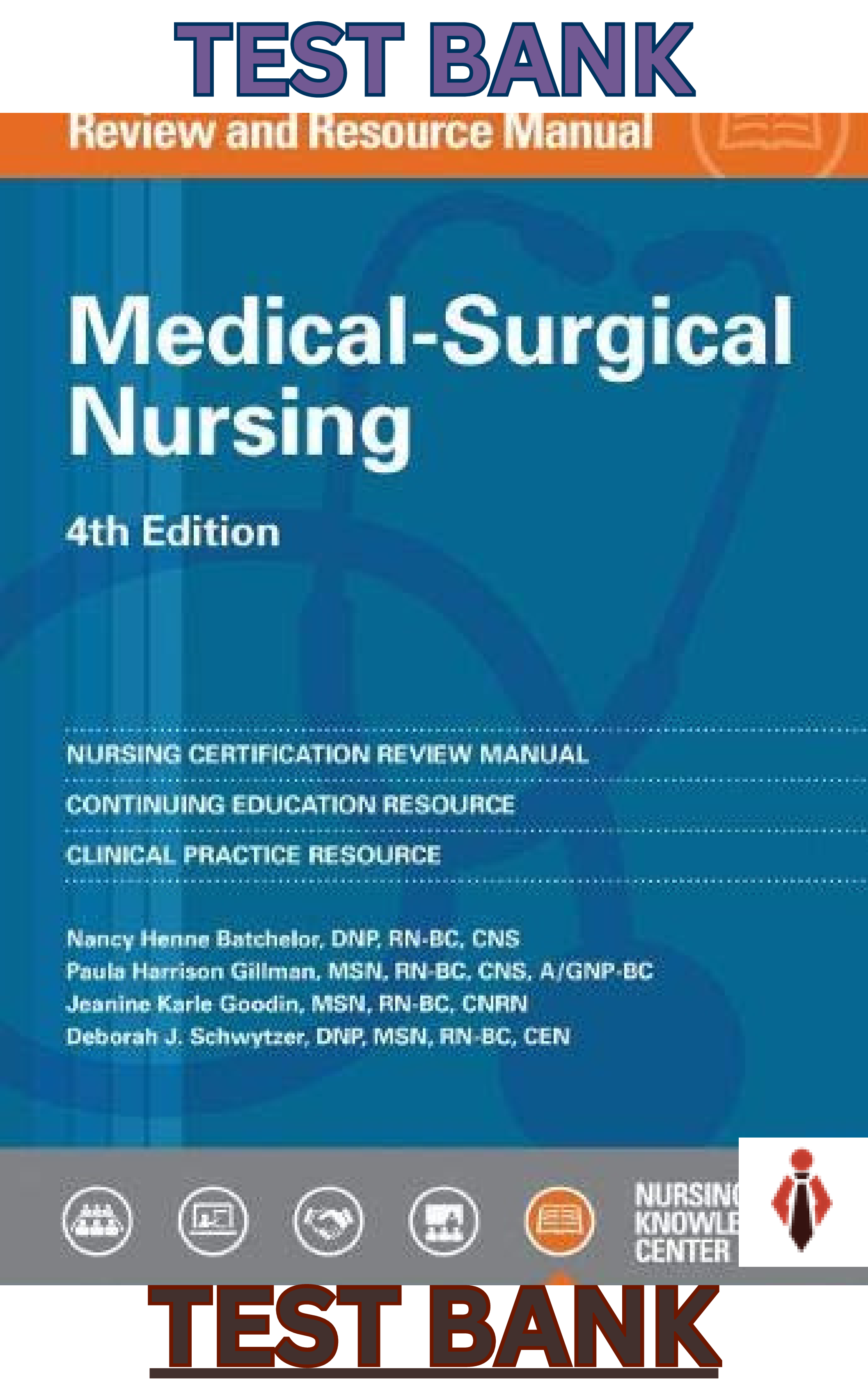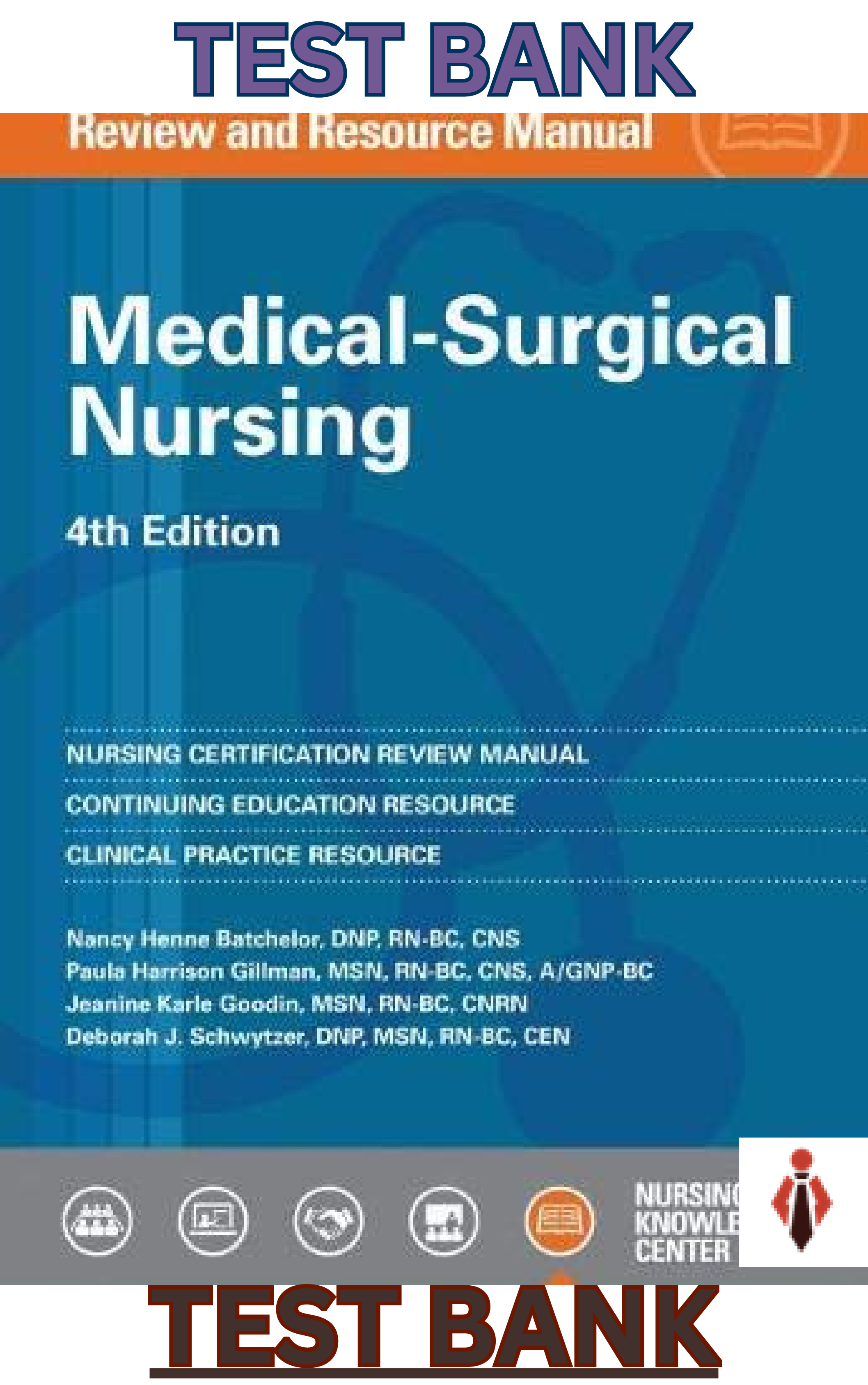*NURSING > TEST BANK > NSG 101 _ TESTBANKS | REVIEW QUESTIONS FINAL EXAM | International Institute for Health Care Professi (All)
NSG 101 _ TESTBANKS | REVIEW QUESTIONS FINAL EXAM | International Institute for Health Care Professionals/ (2020/2021)
Document Content and Description Below
REVIEW QUESTIONS FINAL EXAM Basic Infection Control HAND WASHING REVIEW QUESTIONS 1. How does soap work? a. Emulsifies fat and oil so that dirt and microorganisms can be mechanically ... removed REVIEW QUESTIONS 1. Which personal protective equipment (PPE) will the nurse wear if there is a risk of a blood splash when caring for a patient? 2. What will the nurse do first when preparing to apply personal protective equipment (PPE) before caring for a patient in isolation? 3. The nurse is discussing the guidelines for proper use of PPE by nursing assistive personnel (NAP). Which statement made by the NAP requires follow-up by the nurse? 4. When removing a gown worn as personal protective equipment (PPE) while caring for a patient in isolation, why does the nurse avoid touching the outside of the gown? 5. When delegating patient care that requires nursing assistive personnel (NAP) to use personal protective equipment (PPE), it is necessary for the nurse to do what first? COMPLETE OR PARTIAL BED BATH REVIEW QUESTIONS 1. Which instruction would the nurse give when asking nursing assistive personnel (NAP) to give a complete bed bath to a patient? 2. The nurse has washed a patient’s abdomen. Which area should the nurse wash next? ASSISTING WITH A TUB BATH OR SHOWER REVIEW QUESTIONS 1. Which nursing action reduces the risk of falling as a patient is getting into or out of a bathtub? 2. A patient with left-sided muscle weakness is prescribed a bath every other day. Which precaution would help the nurse reduce this patient’s risk of falling? d. 3. The nurse has just helped a patient into the bathtub. Before leaving the bathroom, what would the nurse do to help ensure the patient's safety? a. Show him how to use the call signal. 4. The nurse is assisting a patient with a tub bath. After the patient has been safely positioned in the tub, he tells the nurse, "I'll call you when I'm done." What is the nurse's best response? 5. The nurse is helping a patient get out of a bathtub, and the patient appears to be unsteady on her feet. What should the nurse do to help ensure the patient’s safety? a. PERFORMING BACK MASSAGE REVIEW QUESTIONS 1. The nurse would not offer back massage to which of the following patients? PERFORMING PERINEAL CARE FOR A FEMALE PATIENT REVIEW QUESTIONS 1. The nurse is delegating to nursing assistive personnel (NAP) the perineal care of a female patient who is totally dependent and confined to bed. Which statement by the NAP requires the nurse's follow-up? 2. The nurse is preparing to provide perineal care for a female patient who is on bed rest. Which patient position should the nurse use for this care? PERFORMING PERINEAL CARE FOR A MALE PATIENT REVIEW QUESTIONS 1. Which of the following interventions directly related to patient safety must the nurse consider when providing perineal care to an elderly male patient with a catheter? UNOCCUPIED BED REVIEW QUESTIONS 1. The nurse who is preparing to make an unoccupied bed should do what to ensure his or her personal safety? OCCUPIED BED REVIEW QUESTIONS 1. The nurse is preparing to make an occupied bed for a patient who is on aspiration precautions. What will the nurse do to ensure the safety of this patient during the bed change? 2. The nurse is directing nursing assistive personnel (NAP) to make an occupied bed. What will the nurse say to minimize the risk of disease transmission to staff and patient during the bed change? 3. Which action ensures that a patient will not have unnecessary pain during a linen change? 4. The nurse is changing the bed linen of a patient on bed rest. When the nurse is ready to make the other side of the bed, what will the nurse do before having the patient turn onto the side that has already been made? SURGICAL BED REVIEW QUESTIONS 1. When making a surgical bed with no patient present, at which time is it unnecessary to perform hand hygiene? 2. A new nursing assistive personnel (NAP) is making a surgical bed for a patient who is having abdominal surgery. Where will you instruct the NAP to place the waterproof pad on this bed? 3. For a surgical bed, why is the linen formed into a triangle and fanfolded away from the side on which the patient will be transferred? 4. A nursing assistive personnel (NAP) has finished making a surgical bed for a patient in surgery. How would the nurse instruct the NAP to leave the bed to transfer the surgical patient safely? 5. When making a surgical bed, why does the nurse avoid shaking the linen being removed from the bed? TEMPERATURE REVIEW QUESTIONS 1. What will the nurse instruct nursing assistive personnel (NAP) to do when measuring a patient’s rectal temperature using an electronic thermometer? 2. Which of the following is contraindicated with taking a rectal temperature measurement? 3. Which nursing action best evaluates the effectiveness of an antipyretic medication in a patient with an oral temperature of 101.6° F? 4. Which instruction might the nurse give to nursing assistive personnel (NAP) that is applicable only to tympanic temperature assessment? 5. Which instruction might the nurse give to nursing assistive personnel (NAP) that is applicable only to temporal artery temperature assessment? RADIAL PULSE REVIEW QUESTIONS 1. During the admissions process, the nurse initially assesses the patient’s radial pulse primarily for what purpose? d. 2. What will the nurse instruct nursing assistive personal (NAP) to do when measuring an adult patient’s radial pulse? 3. What is the nurse’s priority action if a patient’s radial pulse has an irregular rhythm? 4. Inadequate oxygenation to the body will cause the radial pulse to become: 5. Which action would best assess the effect of exercise on a patient’s radial pulse measurement? APICAL PULSE REVIEW QUESTIONS 1. What is the primary purpose of initially assessing an apical pulse? 2. What instruction should the nurse give nursing assistive personnel (NAP) regarding the appropriate technique when measuring the adult patient’s apical pulse? 3. Which action would take priority if a patient’s apical pulse has an irregular rhythm? 4. Which statement demonstrates an understanding of the importance of communicating changes in the patient’s apical pulse rate? 5. The nurse can best determine the effect of crying on a patient’s apical pulse by doing what? APICAL-RADIAL PULSE REVIEW QUESTIONS 1. What is the major health problem resulting from a pulse deficit? RESPIRATION REVIEW QUESTIONS 1. Which action can the nurse take to keep a patient from consciously controlling his or her breathing during an assessment? 2. On the last assessment of a patient's respiration, her respiratory rate was 10 breaths per minute. What should the nurse do when conducting the next assessment of this patient’s respiratory rate? 3. When measuring a patient’s respiratory rate, the nurse will count the number of completed respiratory cycles per minute. What is the definition of a respiratory cycle? 4. During the assessment of a patient’s respiratory rate, when the second hand reaches the 15-second mark, the respiratory count is 8. What should the nurse do at this time? 5. The nurse plans to assess a patient’s respiratory rate; however, the patient has just returned from ambulating to the bathroom. What should the nurse do to minimize the effect of exercise on the patient’s respiratory rate? BLOOD PRESSURE 1 STEP REVIEW QUESTIONS 1. The nurse is planning to measure a patient’s blood pressure. What does the systolic measurement represent? 2. You have assigned a new nursing assistive personnel (NAP) to take routine vital signs. You notice that the NAP’s last three patients have had unusually low blood pressure that you have had to confirm. What is the most likely reason the NAP is obtaining falsely low blood pressure readings? 3. What should the nurse do if the patient’s blood pressure is not within normal limits? 4. What would the nurse do to prevent the spread of infection when assessing a patient’s blood pressure? 5. You have assigned a new nursing assistive personnel (NAP) to take routine vital signs. An experienced NAP has been asked to retake a blood pressure that the newly hired NAP has taken three times this week. As the nurse, what action do you take? BLOOD PRESSURE 2 STEP REVIEW QUESTIONS 1. The nurse is preparing to assess a patient’s blood pressure. What would cause the blood pressure reading to be inaccurately high? 2. What would cause the nurse to delay the assessment of a patient’s blood pressure? 3. The nurse has just measured a patient’s blood pressure and is waiting 2 minutes to measure the pressure again. What is the purpose of taking two measurements? 4. The nurse is teaching a patient about ways to reduce blood pressure. What will the nurse include in these instructions? 5. Where should the nurse measure the blood pressure of a patient recovering from a left- sided mastectomy? OXYGEN SATURATION REVIEW QUESTIONS 1. Which of the following is a risk factor for decreased oxygen saturation level in a patient? 2. What should the nurse teach nursing assistive personnel (NAP) about selecting the appropriate site for measuring a patient’s oxygen saturation level? 3. The nurse measures a patient’s oxygen saturation level as being 83%. What would the nurse do first? 4. The nurse is preparing to measure the oxygen saturation level of a patient with obesity. Which action would help ensure an adequate measurement? y. 5. A patient is prescribed continuous oxygen saturation monitoring. The nurse would confirm that the alarms have been set to which limits? PAIN REVIEW QUESTIONS 1. A nurse is caring for a patient who has just had major abdominal surgery to resect a portion of his colon. What is the most reliable sign that the patient has significant postoperative pain? 2. What will the nurse instruct nursing assistive personnel (NAP) to do regarding the management of a patient’s pain? 3. Which observation indicates that a patient’s pain medication has been effective in managing pain that she rated a 6 out of 10 on a pain rating scale before the intervention? 4. A patient with a herniated disk is scheduled for surgery to fuse two vertebrae in her cervical spine. Which activity is most likely to be a palliative factor for this patient? 5. The nurse notices that his patient has none of the signs and symptoms normally associated with pain, such as diaphoresis, tachycardia, and hypertension. The patient does, however, seem moody and a bit uncooperative. What conclusion does the nurse draw? HEIGHT AND WEIGHT REVIEW QUESTIONS 1. When preparing to measure the height and weight of a newly admitted patient, why would the nurse ask about the patient’s ability to stand? d. 2. A nursing assistive personnel (NAP) is preparing to weigh a resident in a skilled nursing facility. The patient is usually weighed in street clothing and socks, with his shoes off. The patient is currently wearing street clothing with shoes and socks. What will the NAP do to ensure that the patient’s weight is correctly measured? 3. Which step must be taken to ensure accurate measurement of a patient’s daily weight? 4. As the nurse is conducting an admission interview, the patient states, “I’ve lost 30 pounds over the last 4 months.” Which question might the nurse ask to determine if the weight loss was intentional or unintentional? 5. For which patient would the nurse instruct nursing assistive personnel (NAP) to weigh a patient with a bed scale? CANE AND CRUTCHES moved. 3. Move left crutch forward. 4. Move right foot forward. 5. Repeat steps above 1. Begin in the tripod position, maintain weight on the "unaffected" [weight-bearing] extremity 2. Advance both crutches and the affected extremity [crutches are placed forward 6 - 8 inches] 3. Move the "unaffected" weight-bearing foot/leg forward [beyond the crutches] 4. Advance both crutches, and then the affected extremity 5. Continue sequence making steps of equal length crutches: walking up stairs 1. Hold on to rail with on hand and crutches with the other hand 2. step up with the strong (unaffected) leg 3. Bring the "affected" leg and the crutches up "Up with the 'good'" crutches: walking down stairs 1. Place the "affected" leg and the crutches down on the step below; support weight by leaning on the crutches 2. Bring the "unaffected" leg down "Down with the 'bad'" using a cane 1. Cane is used on the good, "unaffected," side to provide support to the opposite lower limb 2. Advance cane simultaneously with the opposite "affected" lower limb 3. The "unaffected" lower limb should assume the first full weight-bearing step on level surfaces using a walker 1. Advance walker approximately 12 inches 2. Advance the "affected" lower limb crutches: sitting down 1. With your crutches, back up to the chair or bed until you feel it behind your knees. Take the crutches from under your arms. Put them together, and hold onto both hand grips with one hand. A cane should be placed from the side of the foot or leg. 4-6 inches; stronger For maximum support when walking with a cane, the patient places the can: 1. forward 15-25cm, keeping the body weight on both legs. 2. The weaker leg is moved forward to the cane so that the body weight is divided between the cane and the stronger leg. 3. The stronger leg is then advanced past the cane so that the weaker leg and body weight are supported by the cane and weaker leg. Administering Intravenous Fluid Therapy Preparing an Infusion Site REVIEW QUESTIONS 1. Which technique is most accurate in identifying an appropriate vein site for IV catheter insertion into the arm? a. Apply a tourniquet to the selected arm 4 to 6 inches above the proposed site. Performing Venipuncture REVIEW QUESTIONS 1. Which action would the nurse perform to best ensure effective insertion of a venous access device into a patient’s arm? a. Anchor the vein by placing a thumb 1 to 2 inches below the site. Dressing the Infusion Site REVIEW QUESTIONS 1. Why is it important to label the gauze dressing covering the site of an intravenous access device with the date, time, and nurse’s initials? 3. What might the nurse do to minimize the risk for injury in a patient receiving IV therapy? REVIEW QUESTIONS 1. What would the nurse do to assess a patient’s risk for embolus when removing a venous access device? Managing Intravenous Fluid Therapy Regulating an Intravenous Infusion REVIEW QUESTIONS 1. Which instruction to nursing assistive personnel (NAP) reflects the nurse’s correct understanding of the NAP’s role in caring for a patient receiving intravenous (IV) fluids by gravity drip? Using an Infusion Pump REVIEW QUESTIONS 1. Which response might the nurse give to nursing assistive personnel (NAP) who reports that the alarm is sounding on a patient’s electronic infusion device? Changing Intravenous Tubing and Fluids REVIEW QUESTIONS 1. After changing the intravenous tubing on a patient’s primary infusion, the nurse notes air bubbles in the tubing. How would the nurse remove them? Changing Intravenous Dressings REVIEW QUESTIONS 1. Which instruction might the nurse give to nursing assistive personnel (NAP) regarding the care of a patient with an intravenous (IV) site dressing? Intravenous Medication Administration Administering IV Medication by Piggyback REVIEW QUESTIONS 1. Which instruction reflects the nurse’s correct understanding of the role of nursing assistive personnel (NAP) in caring for a patient receiving an intravenous (IV) antibiotic medication by piggyback? REVIEW QUESTIONS 1. Which task might the nurse delegate to nursing assistive personnel (NAP) caring for a patient receiving IV medication via mini–infusion pump? 2. Which action by the nurse would reduce his or her exposure to blood borne pathogens while administering fluids to a patient by mini–infusion pump? 3. Which step to protect the patient from infection is of special concern when preparing a mini–infusion pump to deliver an analgesic? 4. What is the most important nursing intervention to ensure the patient’s safety when initiating infusion of an analgesic by mini–infusion pump? 5. What can the nurse do to help protect the patient from infiltration of IV medication? Administering Medications by Intravenous Bolus 1. Which statement might a nurse make to nursing assistive personnel (NAP) when caring for a patient prescribed an intravenous (IV) bolus of analgesic medication? 2. Which patient safety issue is specific to administration of medication by IV bolus? 3. What is the most important action the nurse can take to protect the patient when administering a narcotic analgesic by IV bolus? 4. How can the nurse best minimize the patient’s risk for infection when administering an IV bolus of an analgesic? 5. If the nurse does not see blood return when aspirating the saline lock in preparation 1. What can the nurse do to help protect the patient from infiltration of IV medication? 2. If the nurse does not see blood return when aspirating the saline lock in preparation for an IV bolus medication, what is the next step? 12. Which step to protect the patient from infection is of special concern when preparing a mini–infusion pump to deliver an analgesic? REVIEW TEST 2. If the nurse does not see blood return when aspirating the saline lock in preparation for an IV bolus medication, what is the next step? 3. What is the best way to prevent infection and conserve resources when terminating an IV piggyback medication infusion in a patient who also has a primary fluid infusion? 4. Which task might the nurse delegate to nursing assistive personnel (NAP) caring for a patient receiving IV medication via mini–infusion pump? 5. Which statement might a nurse make to nursing assistive personnel (NAP) when caring for a patient prescribed an intravenous (IV) bolus of analgesic medication? 6. What is the best way to protect a patient from an IV site injury when giving an antibiotic medication by piggyback? 7. How can the nurse best minimize the patient’s risk for infection when administering an IV bolus of an analgesic? 8. Which action by the nurse would reduce his or her exposure to blood borne pathogens while administering fluids to a patient by mini–infusion pump? 9. When administering an IV piggyback medication to infuse by gravity, how can the nurse ensure that the medication will flow properly? 10. Which patient safety issue is specific to administration of medication by IV bolus? 11. What is the most important nursing intervention to ensure the patient’s safety when initiating infusion of an analgesic by mini–infusion pump? REVIEW QUESTIONS Administering Oral Medications Documenting Medication Administration REVIEW QUESTIONS 1. Which example reflects effective documentation of medication administration by a nurse? 2. What is the best way for the nurse to ensure that a patient receives the correct dose of a medication? 3. Which statement best illustrates the nurse’s understanding of the role of nursing assistive personnel (NAP) in documenting medication administration? ." 4. The patient refuses the scheduled dose of an antibiotic, saying that the medication makes him feel nauseated. What it the nurse’s best response? a. Notifying the prescriber of the patient's reason for refusing the medication. 5. While reviewing a new medication order, the nurse notes that the frequency of administration has been omitted. What is the nurse’s best response? a. Immediately contacting the prescriber to complete the order Preparing Injections from an Ampule 1. When preparing an injection from an ampule, what will the nurse do if liquid is trapped in the neck of the ampule? a. Check the medication cabinet for an extra ampule of the medication. 2. What is the greatest safety concern when withdrawing medication from an ampule? a. Withdrawing glass particles into the syringe 3. How does the nurse minimize the risk of patient infection when preparing medication from an ampule? a. Preserving the sterility of the needle while preparing the medication 4. Which action minimizes the risk of introducing glass particles into the syringe when drawing medication from an ampule? Preparing Injections from a Vial 1. A nurse is preparing to withdraw medication from an open multidose vial. After confirming that the vial contains the appropriate medication and checking the expiration date, what would the nurse do next? a. Wipe the rubber seal of the vial with an alcohol swab. Preparing and Administering Insulin 1. How can the nurse best ensure the patient’s safety when preparing insulin for administration? a. Obtain the patient’s current blood glucose level. Drawing up More Than One Type of Insulin 1. The nurse is preparing to mix short- and intermediate-acting insulins to administer to a patient. Which action best preserves the insulin’s effectiveness? a. Refraining from injecting the intermediate-acting insulin into the short-acting vial Administering Intradermal Injections 1. When administering an intradermal injection, which outcome would require the nurse to withdraw the needle and begin again? a. Inability to feel resistance when injecting the medication Administering Subcutaneous Injections. 1. Which action would the nurse take to diminish tissue irritation when administering a subcutaneous injection to a patient of average size? a. Make sure the volume of the medication is less than 2 mL. Administering Intramuscular Injections 1. Which action by the nurse ensures patient safety when administering an intramuscular injection? a. Rotating injection sites 3. Which action minimizes the risk of introducing glass particles into the syringe when drawing medication from an ampule? C. Using a filter needle or straw to draw the medication from the ampule 4. To prevent hypoglycemia and enhance efficacy, it is appropriate to give rapid-acting insulin how many minutes before the next meal? A. 5 to 15 minutes 5. When preparing to administer heparin or insulin subcutaneously, which site is preferred? A. Abdomen 6. Which action would the nurse take to diminish tissue irritation when administering a subcutaneous injection to a patient of average size? B. Make sure the volume of the medication is less than 2 mL. 7. How would the nurse prepare insulin to ensure its efficacy? C. Roll the vial of insulin suspension between the palms prior to drawing up the medication. 8. Which finding tells the nurse that a patient may have had a positive reaction to a tuberculin test? C. A hard, raised area 15 mm or greater in diameter 9. A nurse is preparing to withdraw medication from an open multidose vial. After confirming that the vial contains the appropriate medication and checking the expiration date, what would the nurse do next? C. Wipe the rubber seal of the vial with an alcohol swab. 10. What will the nurse do after opening a multidose vial and withdrawing a dose of medication from it? a. Label the vial with the date it was opened and your initials. 11. Which action by the nurse ensures patient safety when administering an intramuscular injection? B. Rotating injection sites 12. What is the greatest safety concern when withdrawing medication from an ampule? C. Withdrawing glass particles into the syringe 13. What can the nurse do to minimize the discomfort of a subcutaneous injection? C. Cover the injection site with gauze pad after withdrawing the needle. 14. How can the nurse determine that the needle tip for an intradermal injection is in the dermis? C. The bulge of the needle tip will be visible through the skin. 15. What can the nurse do to ensure proper site selection for subcutaneous insulin injection? D. Systematically rotate sites within the same anatomical location or area. 16. Which action might the nurse take when drawing up medication from an ampule? A. Hold the ampule upside down while inserting the filter needle. 17. Which statement might the nurse make to nursing assistive personnel (NAP) when caring for a patient who is prescribed an intradermal injection? C. “Immediately report any patient complaints of itching or dyspnea.” 18. How can the nurse prevent negative pressure from building up in the vial when preparing an injection? A. Inject an amount of air into the vial equivalent to the volume of medication to be withdrawn. 19. The patient is to receive both Lantus® (insulin glargine) and regular insulin. To ensure the proper action of the insulins, what would the nurse do when preparing these two types of insulin for administration? B. Prepare the insulins in two syringes for separate injections. 20. Which of the following statements is accurate regarding insulin administration? C. Vials of insulin must be inspected before each use for changes in appearance. 21. When preparing an injection that contains both short- and intermediate-acting insulins, what is the first step the nurse would take to ensure the effectiveness of the injection? A. Insert air into the intermediate-acting insulin. 22. Which site is most commonly used for intramuscular injections? A. Ventrogluteal 23. How does the nurse minimize the risk of patient infection when preparing medication from an ampule? D. Preserving the sterility of the needle while preparing the medication 24. When preparing an injection of mixed insulin that includes 12 units of NPH and 5 units of regular insulin, how does the nurse initially confirm the proper dosage in the syringe? A. By noting when 5 units of clear insulin is visible in the syringe 25. When preparing an injection from an ampule, what will the nurse do if liquid is trapped in the neck of the ampule? A. Check the medication cabinet for an extra ampule of the medication. Ostomy care REVIEW QUESTIONS 1. What is the nurse’s initial action when preparing to change a patient’s colostomy pouching system? a. Applying clean gloves CORRECT. Applying gloves first will protect the nurse while checking the stoma for leakage and assessing the patient’s skin for irritation. CORRECT. NAP can observe and report anomalies regarding the stoma, the pouch, or its contents. Pouching a Urostomy REVIEW QUESTIONS 1. Which action will the nurse perform first when preparing to change a patient’s urostomy pouching system? 2. When pouching a patient’s urostomy, which nursing action reduces the risk for injury? 3. What will the nurse do to protect the peristomal skin of a patient with a urostomy? 4. Which action would be the nurse’s priority when caring for a patient with a urostomy who had no urine output for 4 hours? 5. Which instruction might the nurse give to nursing assistive personnel (NAP) caring for a patient with a newly established urostomy? QUIZ MEDICATION ADMINISTRATION 20/20 • A patient is to receive nitroglycerin ointment, 1 inch STAT, for elevated blood pressure. What must the nurse do before giving this drug? c. put on a pair of disposable gloves • The nurse is caring for a critically ill patient. What are the contraindications for administering medications by the oral route for this patient? (Select all that apply.) a. Vomiting b. Unconsciousness • The prescriber orders atenolol (Tenormin) 25 mg to be given orally once a day to control a patient’s high blood pressure. The nurse takes the patient's vital signs and finds that the blood pressure is 128/80 and the heart rate is 60 b/m. What does the nurse do first before giving this drug? • When giving a drug to a patient who is awake but confused, what is the best way for the nurse to identify the patient? c. check the name on the patient's wristband. • A 76-year-old client lives alone and takes medications without supervision. Which of the following is the most appropriate question for his home health nurse to ask in regard to his medication regimen? • Nurse is preparing the medications for a patient. The client has ordered 3.75mg of prednisone. The medication comes in 2.5mg tabs. How many tablets will the nurse administer? • What is the best way for the nurse to make sure that the right patient is receiving a prescribed drug when the patient is alert and oriented? D). have the patient state his or her name and birth date. • When is it acceptable for the nurse to take a verbal order from the prescriber before giving a drug to a patient? B). in an emergency situation such as a cardiac arrest • The nurse is giving morning medications to patient who refuses to take an oral dose of docusate (Colace).What is the nurse's best response? d. can you tell me why you do not want to take the docusate? QUIZ INJECTIONS 30/30 • The nurse needs to administer an intramuscular injection to an infant. Which is the most appropriate site to utilize for this patient? Vastus lateralis • The health care provider has ordered the patient to receive 125 mg of a medication. The nurse has the medication available in the form of 62.5 mg per 1.5 mL of solution. How many mL will the nurse administer in order to provide the correct dose? 3 ml 125mg 62.5 mg = 187 = 3 ml 1ml 1.5ml 62.5 • The nurse uses the following landmarks when using the ventrogluteal muscle for intramuscular injection: Greater trochanter, iliac crest, anterior superior iliac spine • The patient is to receive both Lantus (insulin glargine) and regular insulin. To ensure the proper action of the insulins, what would the Nurse do when preparing these two types of insulin for administration? Prepare the insulins in two syringes for separate injections. • The nurse is administering an IM injection the Z-track method is recommended for IM injections because: It minimizes local skin irritation by sealing the medication in muscle tissue. [Show More]
Last updated: 1 year ago
Preview 1 out of 45 pages
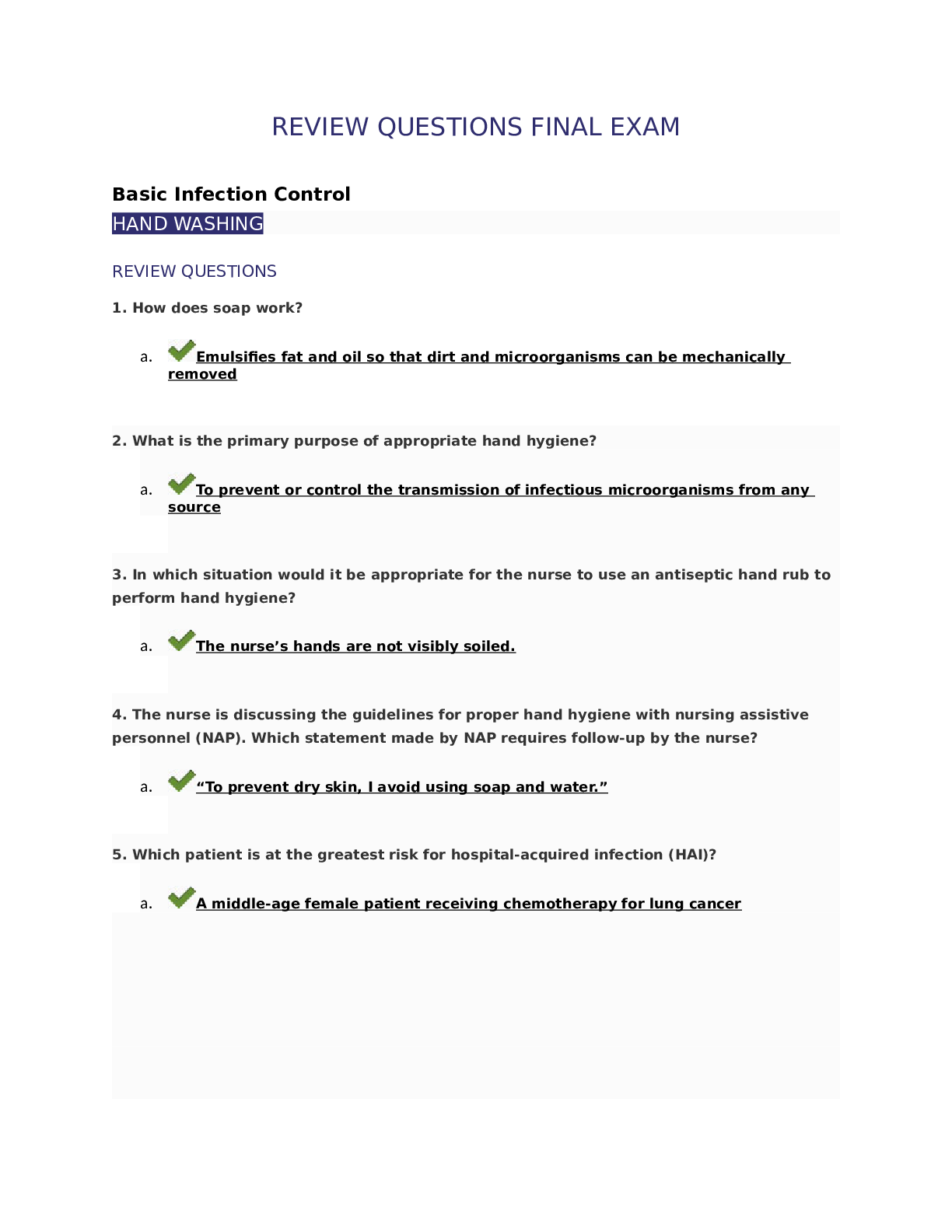
Reviews( 0 )
Document information
Connected school, study & course
About the document
Uploaded On
Mar 14, 2021
Number of pages
45
Written in
Additional information
This document has been written for:
Uploaded
Mar 14, 2021
Downloads
0
Views
47

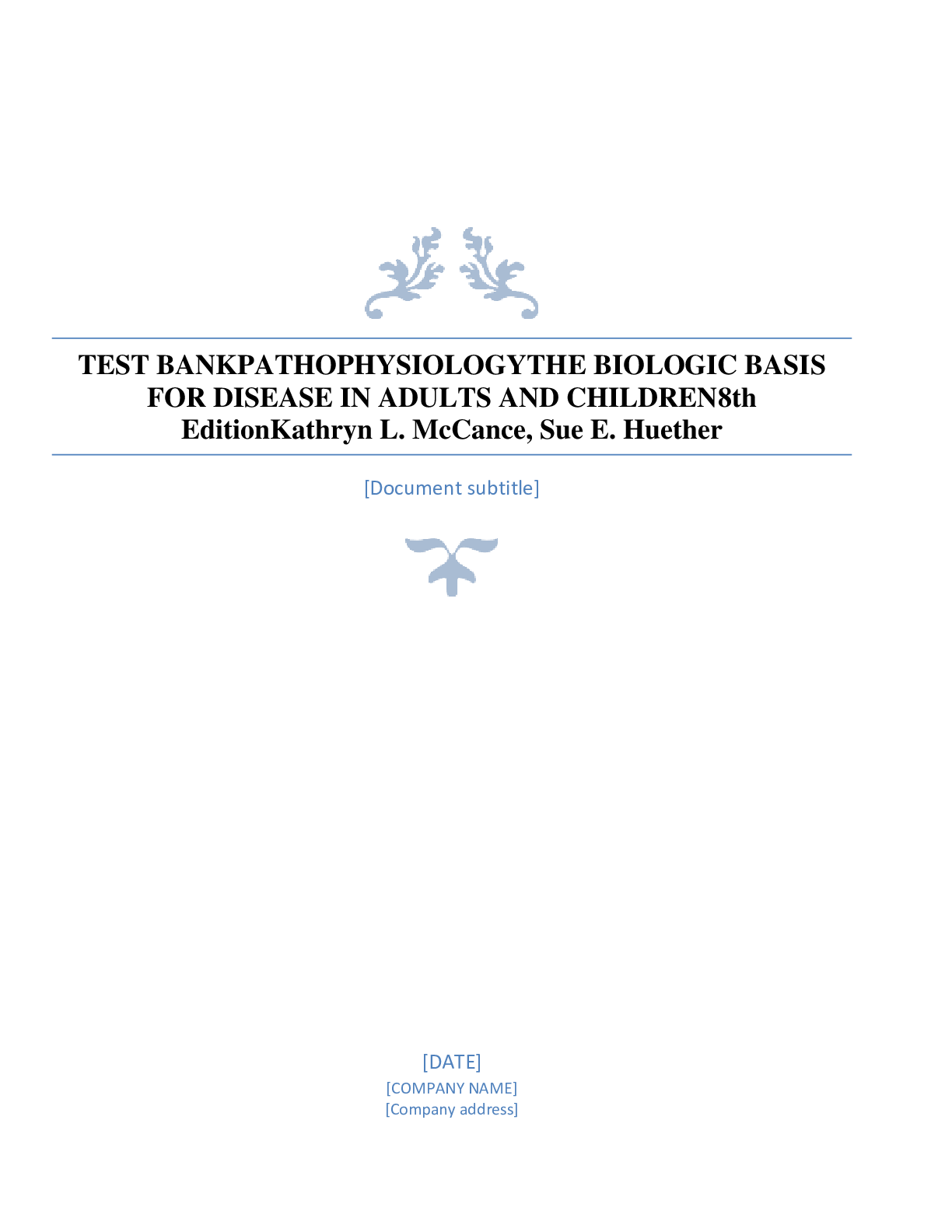


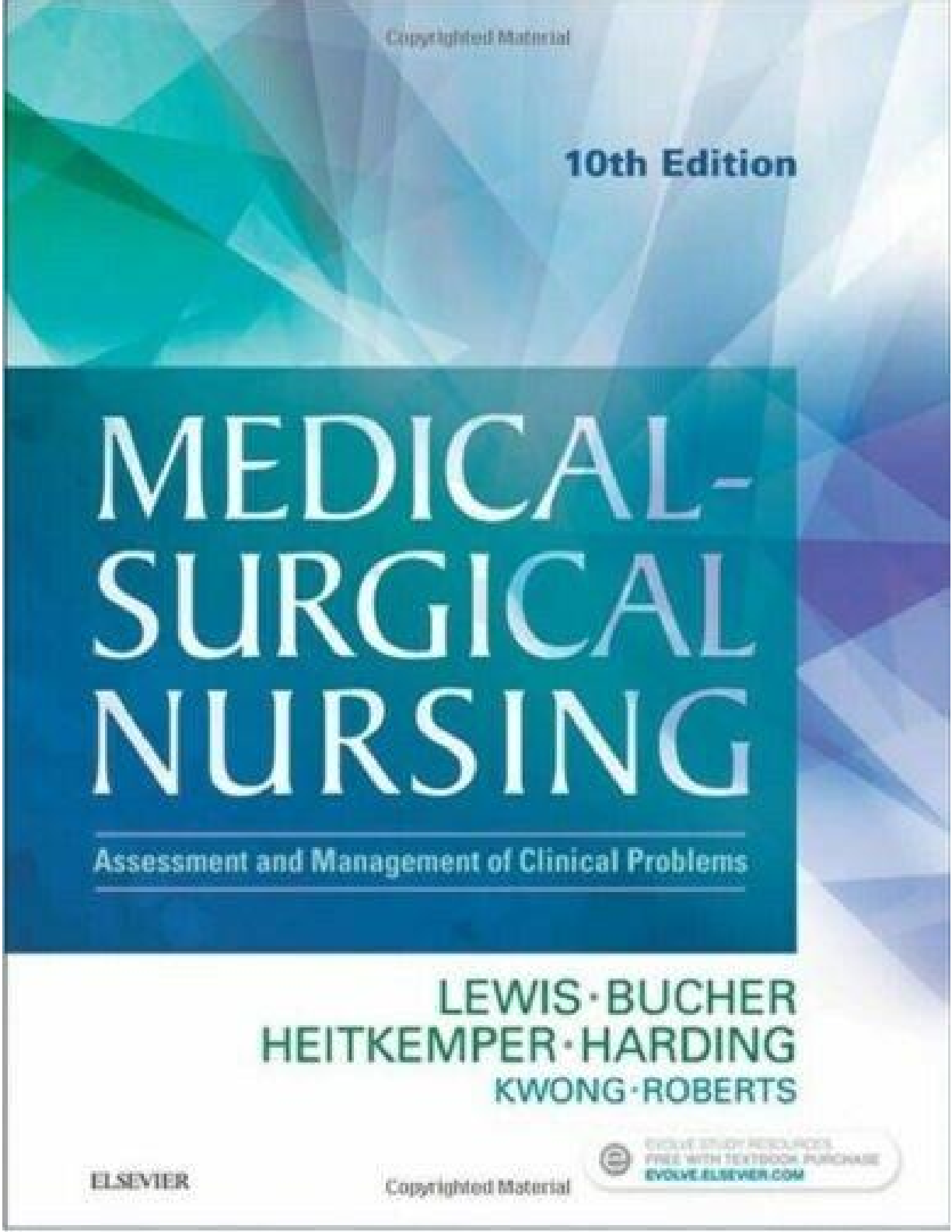
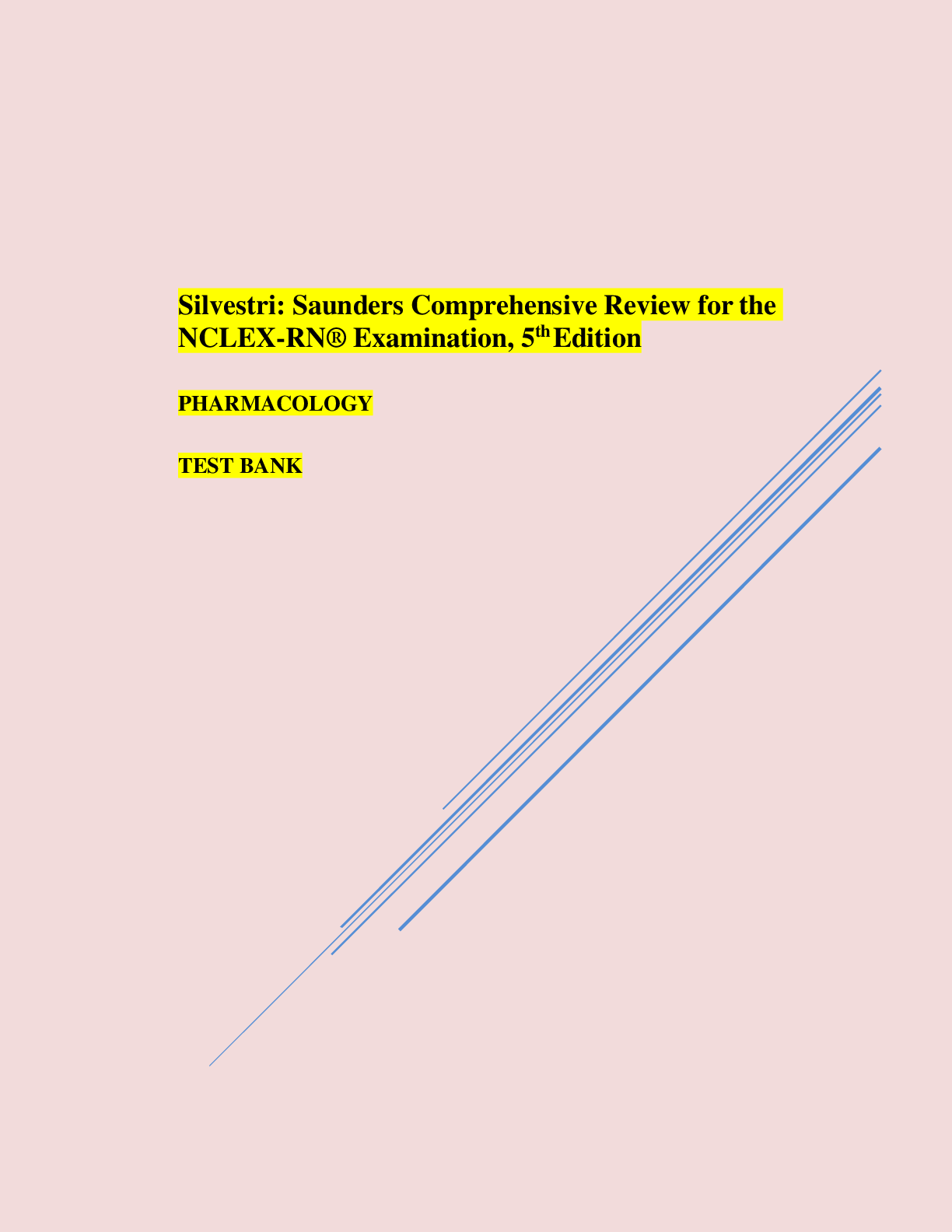


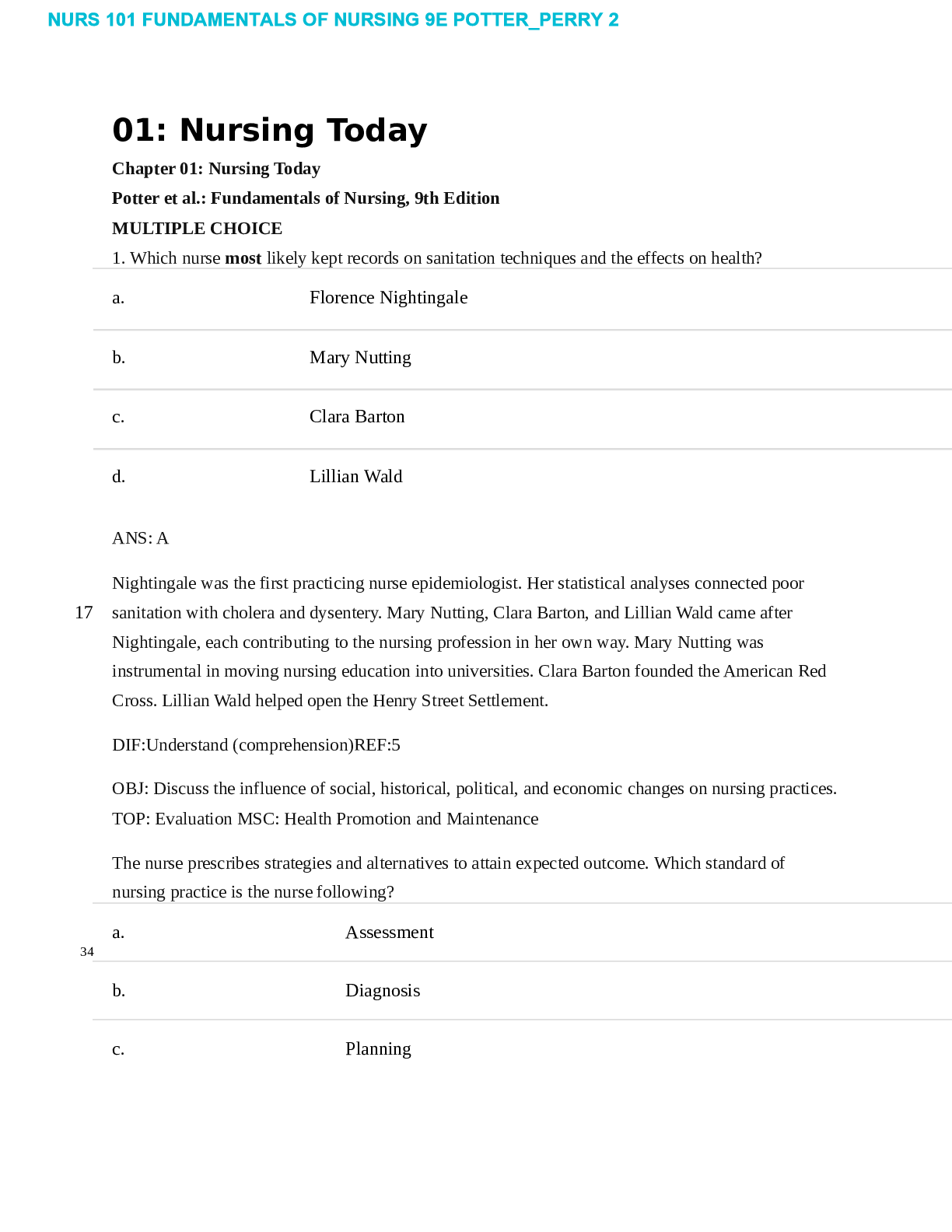

.png)
